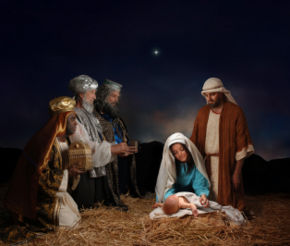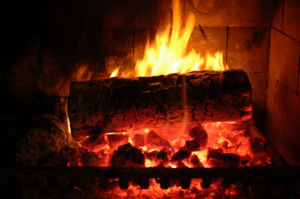History of Christmas
From Giftypedia
The history of Christmas goes back at least 4000 years. Although a Christian holiday, many of the traditions associated with Christmas actually have pagan roots. Christians in the Middle East and Europe began to adapt many of these traditions as a way of reducing the impact pagans had on society.
Traditions from Mesopotamian Culture
Many historians theorize that the Mesopotamians had many traditions that eventually were adapted by Christians. This includes the tradition of the 12 days of Christmas. The Mesopotamians believed in many gods, and their chief god was Marduk. Each year as winter arrived it was believed that Marduk would do battle with the “monsters of chaos.” To assist Marduk in his struggle the Mesopotamians held a festival for the New Year. This was Zagmuk, the New Year's festival that lasted for 12 days. The Mesopotamian king would return to the temple of Marduk and swear his faithfulness to the god. The traditions called for the king to die at the end of the year and to return with Marduk to battle at his side. To spare their king, the Mesopotamians used the idea of a "mock" king. A criminal was chosen and dressed in royal clothes. He was given all the respect and privileges of a real king. At the end of the celebration the "mock" king was stripped of the royal clothes and slain, sparing the life of the real king.
From the ancient Scandinavians came the tradition of celebrating the Yuletide and burning the Yule log. In ancient Scandinavia during the winter months, the sun would disappear for many days. After thirty-five days without sun, scouts would be sent to the mountains to look for the return of the sun. When the first light was seen, scouts would return with the good news. A great festival would be held, called the Yuletide, and a special feast would be served around a fire burning with the Yule log. Great bonfires would also be lit to celebrate the return of the sun. In some areas people would tie apples to branches of trees to remind themselves that spring and summer would return. Many of these traditions traveled to other countries through the Viking explorers. We see this in Scotland, where many of their traditions, such as the celebration of Yule, are similar. The tradition of burning a fire during Christmas has its roots from Yule, as well. The burning of the Yule log is strongly associated with pagan worship of vegetation and fire, as well as being associated with magical and spiritual powers.
Traditions from Ancient Romans
Ancient Romans had a festival in honor of the god of harvest, Saturn, called Saturnalia. Public squares were often decorated with flowers, gifts and candles. According to sources, to avoid persecution during the Roman pagan festival, early Christians decorated their homes with Saturnalia holly. As Christians increased in number, their customs prevailed, the celebrations took on a Christian observance.
However, the early church actually did not celebrate the birth of Christ in December until the second Bishop of Rome, Telesphorus declared that Church services should be held during this time to celebrate "The Nativity of our Lord and Savior." Since no-one was quite sure in which month Christ was born, Nativity was often held in September, during Rosh Hashanah. In fact, for more than 300 years, people observed the birth of Jesus on various dates.
In the year 274AD, solstice fell on 25th of December. Roman Emperor Aurelian proclaimed the date as "Natalis Solis Invicti," the “Festival of the birth of the invincible sun.” In 320 AD, Pope Julius I specified the 25th of December as the official date of the birth of Jesus Christ.
Ancient Europeans believed in evil spirits, witches, ghosts and trolls. As the Winter Solstice approached, with its long cold nights and short days, many people feared the sun would not return. Special rituals and celebrations were held to welcome back the sun. In 325AD, Constantine the Great, the first Christian Roman emperor, introduced Christmas as an immovable feast on December 25th. He also introduced Sunday as a holy day in a new 7-day week, and introduced movable feasts such as Easter. In 354AD, Bishop Liberius of Rome officially ordered his members to celebrate the birth of Jesus on December 25. Before that the birth of Jesus was celebrated on January 6th.
Other Christmas Traditions
The Celts started the Christmas tradition of using mistletoe and holly, as these plants represent fertility.
The tradition of reenacting the nativity started in Italy. This was supposedly a tradition started by St. Francis of Assisi in 1223 in order to bring spiritual knowledge to worshipers.
In 1834, when Britain's Queen Victoria married Prince Albert, a German, it introduced the tradition of the Christmas tree and carols that were held in Continental Europe to the British Empire.
In the Czech Republic, a bell is rung on Christmas Eve signaling that Baby Jesus has left presents under the tree for the children.
In Egypt, Egyptian Christians (Coptic Christians) celebrate Christmas on January 7. As in the West, children are the focus and receive gifts from family.
In most Greek homes a sign of the season is a shallow wooden bowl with a piece of wire suspended across the rim. From the wire hangs a sprig of basil wrapped around a wooden cross. A small amount of water is kept in the bowl to keep the basil alive. Once a day, a family member, dips the cross and basil into some holy water and uses it to sprinkle water in each room of the house. This ritual is believed to keep the Killantzaroi, (bad spirits) away.
In Spain, on Christmas Eve as dusk arrives many families will place tiny oil lamps in their windows, or light candles around their nativity scenes, it is believed that the light will help to guide the Christ child to each home.
In Portugal, children place their shoes near the fireplace as a receptacle for presents delivered by "Pai Natal" or "Father Christmas" with the help of Baby Jesus. The Christ Child is not added to the family's nativity scene until after the family attends Midnight Mass.
In multicultural Switzerland, Christmas is celebrated in many ways. Children are told that the presents were by the Christkind (German), Le petit Jésus (French), or Gesu Bambino (Italian).
Christmas is also known as Feast of Candles in Denmark. As charity, candles, food and money are given to the poor.
In the Ukraine, Christmas is a very important family holiday, which includes serving a Christmas Eve meal that consists of twelve dishes or courses that are meatless and do not contain dairy products. Each of these courses represent one of the twelve apostles that shared the last supper with Jesus.
Want to spend Christmas on the beach enjoying warm weather and the sun? If you travel to New Zealand for Christmas that is exactly what you will do. Since Christmas falls in the New Zealand summer season many will spend Christmas at the beach having picnics and barbeques.
One of the most famous Christmas traditions of all time originated in Austria. In 1818, Silent Night was composed and adapted to guitar to provide music for Midnight Mass because the local church's organ was broken.
The Increasing Popularity of Christmas
In the early 1600s religious reform changed the way Christmas was celebrated in Europe. Until that time Christmas traditionally had been celebrated raucously in a drunken, carnival-like atmosphere similar to today's Mardi Gras Festival. When the Puritans led by Oliver Cromwell took over England they cancelled the celebration of Christmas in order to change the way the holiday was celebrated.
After the Revolutionary War many English traditions fell out of favor including Christmas. Actually the first Christmas under America's new constitution congress was in session on December 25, 1789. Christmas wasn't declared a federal holiday until June 26, 1870.
Although celebrated by many over the years, the popularity of Christmas didn't really take off until 1820 when Washington Irving wrote The Keeping of Christmas at Bracebridge Hall .
A week before Christmas in 1834, Charles Dickens published A Christmas Carol . The story was so popular that neither the churches nor the governments could continue to ignore the importance of celebrating Christmas.
In 1836, Alabama became the first state in the US to declare Christmas as a legal holiday. In 1860, American illustrator Thomas Nast borrowed from European stories about Saint Nicholas, the patron saint of children, to create Father Christmas, also known as Santa Claus. In 1907, Oklahoma became the last US state to declare Christmas a legal holiday. Year by year, countries all over the world began to recognize Christmas Day as a day for celebrating.
Related Guides
Resources
- Did You Know.org - History of Christmas
- Holidays.net - The History of Christmas
- History.com - The History of Christmas
- Christmas-time.com - The History of Christmas





 Printer Friendly
Printer Friendly
